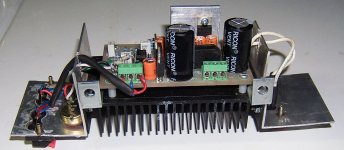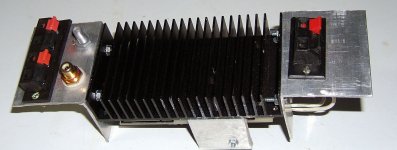I enclose the pictures of a subwoofer amp module I completed.Here are the details
Out put power- 25 watts rms max
AC input- 18-0-18 2A
Input- Both low level and line level
Subwoofer filter type- Sallen &Key 18db/octave
Crossover frequency – 200 cycles
Power amp IC LM1875
I can furnish any other information if requested
Out put power- 25 watts rms max
AC input- 18-0-18 2A
Input- Both low level and line level
Subwoofer filter type- Sallen &Key 18db/octave
Crossover frequency – 200 cycles
Power amp IC LM1875
I can furnish any other information if requested
Attachments
Sub woofer DIY
Thanks for your query
I wanted to add bass to a pair of computer speakers.
I drafted the circuit,designed the PCB in Eagle,got the PCB manufactured by Futurlec in China and assembled the module.I am feeding this into a 13 liter bass reflex ported cabinet made by me in 3/4" MDF.The speaker is a 6 1/2 inch Dayton woofer DC160s-4 from PartsExpress.They sound great.
Yes you are right in that they dont deliver heart thumping bass but more than serve the purpose for which they were made.
I have one extra PCB for the module.If anybody is interested ,let me know.
Thanks for your query
I wanted to add bass to a pair of computer speakers.
I drafted the circuit,designed the PCB in Eagle,got the PCB manufactured by Futurlec in China and assembled the module.I am feeding this into a 13 liter bass reflex ported cabinet made by me in 3/4" MDF.The speaker is a 6 1/2 inch Dayton woofer DC160s-4 from PartsExpress.They sound great.
Yes you are right in that they dont deliver heart thumping bass but more than serve the purpose for which they were made.
I have one extra PCB for the module.If anybody is interested ,let me know.
For the sub from pic number 1 about25 rms for a subwoofer amp? You sure you didn't mean tweeter amp?jk but what subs are you driving with this??
http://www.diyaudio.com/forums/mult...dy-present-inwall-subwoofer-esl-dynamicl.html
10 watts rms is much more than enough !!!
For security reasons (to prevent hearing damage and glass breakage) you should not use amplifiers with higher output power.
The only reason for the use of six drivers is to achieve a homogeneous bass (without maximas and zeros) throughout the room.
Last edited:
I want to also publish an excerpt from the Philips Eindhoven book on power amplifiers published way back but which still holds. I have copied it verbatim with no embellishments from my side.
"Because of the large number of variables affecting room acoustics it is only possible to approximate the power requirements for high fidelity reproduction. Realistic results can be obtained using the following simplified method of determination. The acoustic power at Threshold of hearing at 100Hz can be taken to be
P (threshold) =1X10 -14 V/t watts where “V” is the volume of room in cubic meters and T is the reverberation time in Seconds. For small rooms up to say 100m3 , T has a value of 0.5 seconds.
Assuming that the listening room measures 5 meters long 4 meters wide and 3meters high the volume will be 60 m3.For max of 90 db above the threshold mentioned above the acoustic power will be
P max=(4x10-14x60x109) / .5 =4.8mw
Taking the efficiency of the speaker system to be 1% the electrical power input would be
100x4.8mw=0.48 w
The ear is less sensitive to bass at low volumes and the relation is depicted in the Fletcher Munson curves
It can be seen from them that at 90 db the curves are substantially flat over the bass region and so the relatively low electrical power of .48 w will be adequate to reproduce the signal at a signal level of 90 db over the whole band.
However if we examine the curve for 30 cycles and considering that the low listening level is in the range of 50 db we can see that the low frequencies have to be bumped up by 20 db or so. This is usually provided in the amplifier by a tone control with 20db boost/cut usually of the baxandall design.
Hence the power requirement comes to .48wx100=48W.
In calculating the above power requirement we have not considered speaker positioning.Usualy subwoofers are heavy and are placed on the ground against a wall or corner. Because of the reflecting nature of the walls the apparent power is amplified by 8 times for a corner and 4 times against a wall.
Also the efficiency of 1% used in the above calculation is for a closed box design. Usually all subwoofer enclosures are of the bass reflex design with efficiencies typically 2.5 to 3 times the closed box efficiency over the sub woofer frequencies up to 200 cycles.
In summary even for a fairly large room a power of 50 watts is more than sufficient for the sub woofer.
A 25w rms subwoofer is more than sufficient for a moderate size room unless you want to develop hearing and heart issues.
"Because of the large number of variables affecting room acoustics it is only possible to approximate the power requirements for high fidelity reproduction. Realistic results can be obtained using the following simplified method of determination. The acoustic power at Threshold of hearing at 100Hz can be taken to be
P (threshold) =1X10 -14 V/t watts where “V” is the volume of room in cubic meters and T is the reverberation time in Seconds. For small rooms up to say 100m3 , T has a value of 0.5 seconds.
Assuming that the listening room measures 5 meters long 4 meters wide and 3meters high the volume will be 60 m3.For max of 90 db above the threshold mentioned above the acoustic power will be
P max=(4x10-14x60x109) / .5 =4.8mw
Taking the efficiency of the speaker system to be 1% the electrical power input would be
100x4.8mw=0.48 w
The ear is less sensitive to bass at low volumes and the relation is depicted in the Fletcher Munson curves
It can be seen from them that at 90 db the curves are substantially flat over the bass region and so the relatively low electrical power of .48 w will be adequate to reproduce the signal at a signal level of 90 db over the whole band.
However if we examine the curve for 30 cycles and considering that the low listening level is in the range of 50 db we can see that the low frequencies have to be bumped up by 20 db or so. This is usually provided in the amplifier by a tone control with 20db boost/cut usually of the baxandall design.
Hence the power requirement comes to .48wx100=48W.
In calculating the above power requirement we have not considered speaker positioning.Usualy subwoofers are heavy and are placed on the ground against a wall or corner. Because of the reflecting nature of the walls the apparent power is amplified by 8 times for a corner and 4 times against a wall.
Also the efficiency of 1% used in the above calculation is for a closed box design. Usually all subwoofer enclosures are of the bass reflex design with efficiencies typically 2.5 to 3 times the closed box efficiency over the sub woofer frequencies up to 200 cycles.
In summary even for a fairly large room a power of 50 watts is more than sufficient for the sub woofer.
A 25w rms subwoofer is more than sufficient for a moderate size room unless you want to develop hearing and heart issues.
Attachments
- Status
- This old topic is closed. If you want to reopen this topic, contact a moderator using the "Report Post" button.

